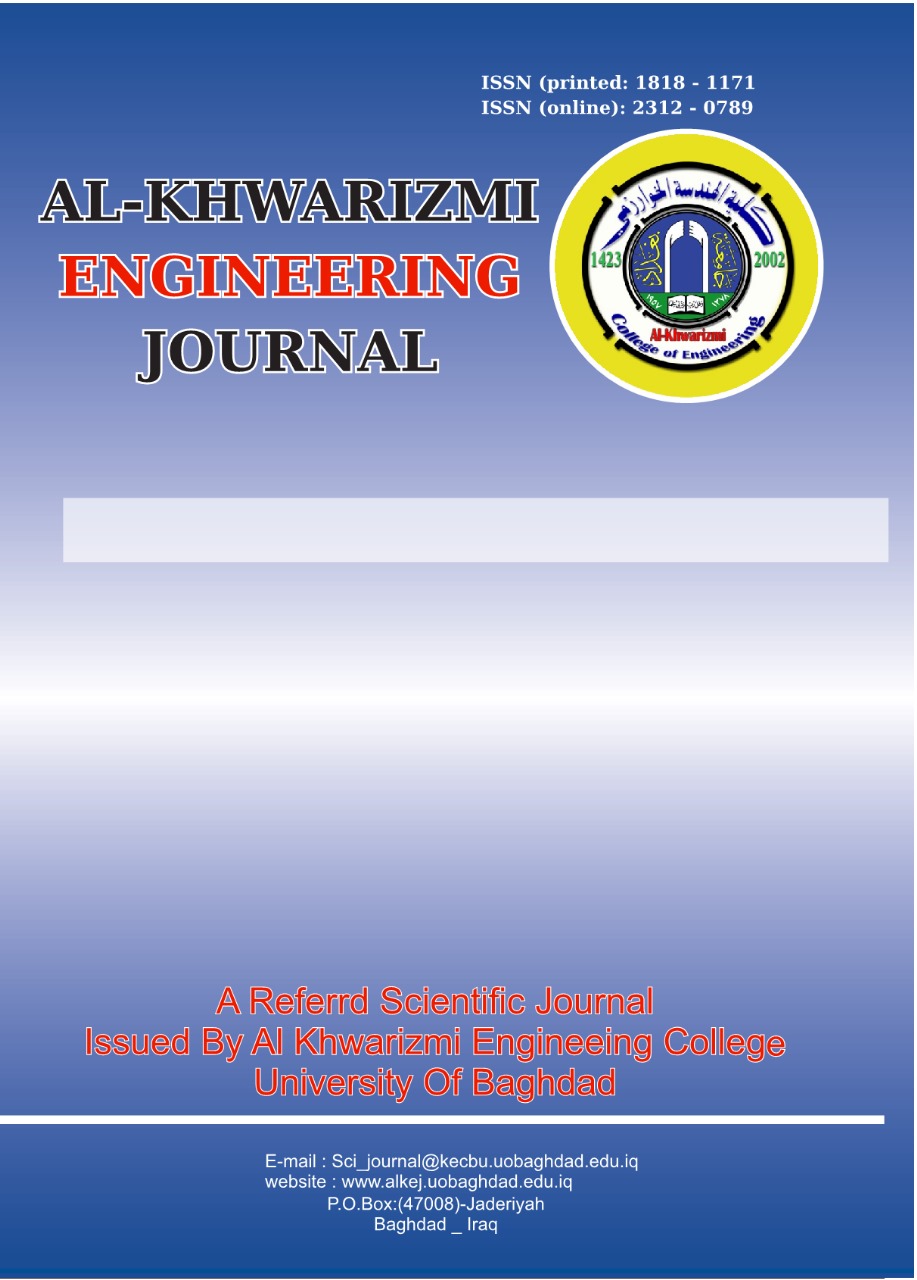Violence Prediction Estimation in Surveillance Cameras Using CNN with GAMMA Correction
DOI:
https://doi.org/10.22153/kej.2025.11.004الكلمات المفتاحية:
anomaly detection, surveillance cameras, Convolutional Neural Network (CNN), Deep Learning, Violence detection, Support Vector Machine.الملخص
In recent years, the deployment of surveillance cameras has significantly increased to enhance security in public and private spaces. Numerous businesses continue to employ individuals to monitor these cameras. However, unusual and suspicious activities in the video feeds are often overlooked due to the potential for human error. Consequently, manual monitoring of security cameras can be time-consuming and inefficient. This study investigates the application of deep learning techniques, particularly convolutional neural networks (CNNs) and support vector machines (SVMs), to predict violence in surveillance video streams. The proposed CNN model is optimised through the utilisation of gamma correction as a preprocessing step to extract essential spatial features from video frames, significantly enhancing the accuracy of violence detection. This study leverages the real-time capabilities of surveillance data by utilising the RLV dataset, which comprises a range of violent and non-violent scenarios. The CNN–SVM hybrid model developed in this study achieved an impressive 99% accuracy, outperforming traditional methods and demonstrating strong spatial feature extraction capabilities. Furthermore, this study addresses the challenges of real-time video surveillance by ensuring scalability and practical applicability, providing a robust solution for enhancing security measures in public and private spaces.
التنزيلات
المراجع
[1] Geetha, R., Gunanandhini, S., Srikanth, G. U., & Sujatha, V. (2024). Human Stress Detection in and Through Sleep Patterns Using Machine Learning Algorithms. Journal of The Institution of Engineers (India): Series B, 1-23.
[2] Tian, B.; Morris, B.T.; Tang, M.; Liu, Y.; Yao, Y.; Gou, C.; Shen, D.; Tang, S. Hierarchical and networked vehicle surveillance in its:A survey. IEEE Trans. Intell. Transp. Syst. 2017, 18, 25–48. [CrossRef]
[3] Varadarajan, J.; Odobez, J.M. Topic models for scene analysis and abnormality detection. In Proceedings of the 2009 IEEE 12th International Conference on Computer Vision Workshops, ICCV Workshops, Kyoto, Japan, 27 September–4 October 2009;pp. 1338–1345
[4] Liu, M. C., Hsu, F. R., & Huang, C. H. (2024). Complex event recognition and anomaly detection with event behavior model. Pattern Analysis and Applications, 27(2), 51.
[5] Vosta, S., & Yow, K. C. (2022). A cnn-rnn combined structure for real-world violence detection in surveillance cameras. Applied Sciences, 12(3), 1021.
[6] Han, D., Wang, Z., Chen, W., Wang, K., Yu, R., Wang, S., ... & Yin, X. (2023).
[7] Anomaly Detection in the Open World: Normality Shift Detection, Explanation, and Adaptation. In NDSS.
[8] Park, H., Noh, J., & Ham, B. (2020). Learning memory-guided normality for anomaly detection. In Proceedings of the IEEE/CVF conference on computer vision and pattern recognition (pp. 14372-14381).
[9] Dong, N.; Jia, Z.; Shao, J.; Xiong, Z.; Li, Z.; Liu, F.; Zhao, J.; Peng, P. Traffic abnormality detection through directional motion behavior map. In Proceedings of the 2010 7th IEEE International Conference on Advanced Video and Signal Based Surveillance,Boston, MA, USA, 29 August–1 September 2010; pp. 80–84
[10] Loy, C.C.; Xiang, T.; Gong, S. Detecting and discriminating behavioural
[11] anomalies. Pattern Recognit. 2011, 44, 117–132. [CrossRef]
[12] Theves, S., Fernandez, G., & Doeller, C. F. (2019). The hippocampus encodes distances in multidimensional feature space. Current Biology, 29(7), 1226-1231.
[13] Cheng, L., Luo, S., Li, B., Liu, R., Zhang, Y., & Zhang, H. (2023). Multiple-instance learning for EEG based OSA event detection. Biomedical Signal Processing and Control, 80, 104358.
[14] Li, T., Wang, Z., Liu, S., & Lin, W. Y. (2021). Deep unsupervised anomaly detection. In Proceedings of the IEEE/CVF winter conference on applications of computer vision (pp. 3636-3645).
[15] Nezamabadi, K., Sardaripour, N., Haghi, B., & Forouzanfar, M. (2022). Unsupervised ECG analysis: A review. IEEE Reviews in Biomedical Engineering, 16, 208-224.
[16] Usmani, U. A., Happonen, A., & Watada, J. (2022, July). A review of unsupervised machine learning frameworks for anomaly detection in industrial applications. In Science and Information Conference (pp. 158-189). Cham: Springer International Publishing.
[17] Fan, C., Liu, Y., Liu, X., Sun, Y., & Wang, J. (2021). A study on semi-supervised learning in enhancing performance of AHU unseen fault detection with limited labeled data. Sustainable Cities and Society, 70, 102874.
[18] Baradaran, M., & Bergevin, R. (2024). A critical study on the recent deep learning based semi-supervised video anomaly detection methods. Multimedia Tools and Applications, 83(9), 27761-27807.
[19] Ramírez-Sanz, J. M., Maestro-Prieto, J. A., Arnaiz-González, Á., & Bustillo, A. (2023). Semi-supervised learning for industrial fault detection and diagnosis: A systemic review. ISA transactions.
[20] Available online: https://visionlab.uncc.edu/download/summary/60-data/477-ucf-anomaly-detection-dataset (accessed on 12January 2018).
[21] Duong, H. T., Le, V. T., & Hoang, V. T. (2023). Deep learning-based anomaly detection in video surveillance: a survey. Sensors, 23(11), 5024.
[22] Liu, C. H., Chen, Z., & Zhan, Y. (2019). Energy-efficient distributed mobile crowd sensing: A deep learning approach. IEEE Journal on Selected Areas in Communications, 37(6), 1262-1276.
[23] Sreenu, G., & Durai, S. (2019). Intelligent video surveillance: a review through deep learning techniques for crowd analysis. Journal of Big Data, 6(1), 1-27.
[24] Farooq, M. U., Saad, M. N. M., & Khan, S. D. (2022). Motion-shape-based deep learning approach for divergence behavior detection in high-density crowd. The Visual Computer, 1- 25.
[25] Behera, S., Vijay, T. K., Kausik, H. M., & Dogra, D. P. (2021, November). PIDLNet: A physics-induced deep learning network for characterization of crowd videos. In 2021 17th IEEE International Conference on Advanced Video and Signal Based Surveillance (AVSS) (pp. 1-8). IEEE.
[26] Varghese, E. B., Thampi, S. M., & Berretti, S. (2020). A psychologically inspired fuzzy cognitive deep learning framework to predict crowd behavior. IEEE Transactions on Affective Computing, 13(2), 1005 1022.
[27] Peixoto, B., Lavi, B., Martin, J. P. P., Avila, S., Dias, Z., & Rocha, A. (2019, May). Toward subjective violence detection in videos. In ICASSP 2019-2019 IEEE International Conference on Acoustics, Speech and Signal Processing (ICASSP) (pp. 8276-8280). IEEE.
[28] Soliman, M. M., Kamal, M. H., Nashed, M. A. E. M., Mostafa, Y. M., Chawky, B. S., & Khattab, D. (2019, December). Violence recognition from videos using deep learning techniques. In 2019 Ninth International Conference on Intelligent Computing and Information Systems (ICICIS) (pp. 80-85). IEEE.
[29] Abdali, A. M. R., & Al-Tuma, R. F. (2019, March). Robust real-time violence detection in video using cnn and lstm. In 2019 2nd Scientific Conference of Computer Sciences (SCCS) (pp. 104-108). IEEE.
[30] Jain, A., & Vishwakarma, D. K. (2020). Deep NeuralNet For Violence Detection Using Motion Features From Dynamic Images. In 2020 Third International Conference on Smart Systems and Inventive Technology (ICSSIT). https://doi.org/10.1109/icssit48917.2020.9214153
[31] Sernani, P., Falcionelli, N., Tomassini, S., Contardo, P., & Dragoni, A. F. (2021). Deep Learning for Automatic Violence Detection: Tests on the AIRTLab Dataset. IEEE Access, 9, 160580–160595. https://doi.org/10.1109/access.2021.3131315
[32] Kang, M., Park, R., & Park, H. (2021). Efficient Spatio-Temporal Modeling Methods for Real-Time Violence Recognition. IEEE Access, 9, 76270–76285. https://doi.org/10.1109/access.2021.3083273
[33] Gadelkarim, M., Khodier, M., & Gomaa, W. (2022). Violence Detection and Recognition from Diverse Video Sources. In 2022 International Joint Conference on Neural Networks (IJCNN). https://doi.org/10.1109/ijcnn55064.2022.9892660
[34] Honarjoo, N., Abdari, A., & Mansouri, A. (2021). Violence Detection Using OneDimensional Convolutional Networks. https://doi.org/10.1109/ikt54664.2021.9685835
[35] Guedes, A. R. M., & Cámara-Chávez, G. (2020). Real-Time Violence Detection in Videos Using Dynamic Images. https://doi.org/10.1109/clei52000.2020.00065.
[36] Real life Violence Situation dataset details,[Availablonline]:https://paperswithcode.com/dataset/real-life-violence-situations-dataset.
[37] Kim J H, Song J H and Lim D H 2020. CT Image Denoising Using Inception Model. Journal of the Korean Data And Information Science Society, 31 (3), pp. 487–501.
[38] Ryoo, M. S., & Aggarwal, J. K. (2009, September). Spatio-temporal relationship match: Video structure comparison for recognition of complex human activities. In 2009 IEEE 12th international conference on computer vision (pp. 1593-1600). IEEE.
[39] Zhong, J. X., Li, N., Kong, W., Liu, S., Li, T. H., & Li, G. (2019). Graph convolutional label noise cleaner: Train a plug-and-play action classifier for anomaly detection. In Proceedings of the IEEE/CVF conference on computer vision and pattern recognition (pp. 1237-1246).
[40] Sultani, W., Chen, C., & Shah, M. (2018). Real-world anomaly detection in surveillance videos. In Proceedings of the IEEE conference on computer vision and pattern recognition (pp. 6479-6488).
التنزيلات
منشور
إصدار
القسم
الرخصة
الحقوق الفكرية (c) 2025 مجلة الخوارزمي الهندسية

هذا العمل مرخص بموجب Creative Commons Attribution 4.0 International License.
حقوق الطبع والنشر: يحتفظ مؤلفو الوصول المفتوح بحقوق الطبع والنشر لاعمالهم، ويتم توزيع جميع مقالات الوصول المفتوح بموجب شروط ترخيص Creative Commons Attribution License، والتي تسمح بالاستخدام غير المقيد والتوزيع والاستنساخ في أي وسيط، بشرط ذكر العمل الأصلي بشكل صحيح. إن استخدام الأسماء الوصفیة العامة، والأسماء التجاریة، والعلامات التجاریة، وما إلی ذلك في ھذا المنشور، حتی وإن لم یتم تحدیدھ بشکل محدد، لا یعني أن ھذه الأسماء غیر محمیة بموجب القوانین واللوائح ذات الصلة. في حين يعتقد أن المشورة والمعلومات في هذه المجلة صحيحة ودقيقة في تاريخ صحتها، لا يمكن للمؤلفين والمحررين ولا الناشر قبول أي مسؤولية قانونية عن أي أخطاء أو سهو قد يتم. لا يقدم الناشر أي ضمان، صريح أو ضمني، فيما يتعلق بالمواد الواردة في هذه الوثيقة.















